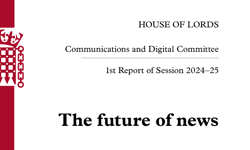When Maureen Duffy presents her latest five-year run of advertising revenue numbers to the managing directors of national newspapers this month (March), they should be waiting with properly chilled champagne.
The chief executive of the Newspaper Marketing Agency will be able to show that, guess what – spending money on marketing actually works. Duffy can demonstrate that the advertising categories where the NMA has concentrated its efforts have, between 2003 and 2007, "conservatively" produced extra revenue of £169 million.
The cost of not marketing
"Before the NMA was set up, the industry had worked out for themselves that they had literally, collectively lost hundreds of millions of pounds in the decline in the share of advertising revenue they were taking," says Duffy, a former head of daytime programming for ITV.
"There was no sign that this was going to stop or any sign of a fall in the pace of decline, so for their business that is pretty substantial," adds Duffy.
Do nothing and the fear was that a multiple series of problems could eventually undermine the economic viability of newspapers. It wasn’t just a case of newspapers losing advertising share overall to competing media such as the internet. Unfortunately, newspapers also happened to be strongest in categories such as finance, motors and mail order which were all in decline. To make matters worse, while some major advertisers scarcely used newspapers at all, those who did, saw newspapers as suitable merely for tactical and short-term campaigns rather than brand-building exercises.
The latest numbers show that, last year, newspapers increased net revenue share from 13.7% to 14%, a result beaten only by the internet and outdoor. For the papers, the small percentage rise adds up to £35 million more in revenue.
Impact of the NMA
The NMA can also argue that there is "a very strong correlation" between NMA research and intervention and newspaper performance in a particular advertising category.
The key percentages across five years, which should bring a smile to the face of newspaper managements, indexed against all media, are as follows:
* advertising categories with no NMA research so far, are down by 7%.
* categories where audience research alone has been carried out are down by 4%.
* where full insight research has been conducted with advertisers, there has been an increase of 11%.
Now, in another significant shift, 47% of newspaper advertising revenue comes from high growth categories such as business, household equipment and entertainment compared with 35% five years ago. And, for the second year in a row, national newspapers’ share of total media spending rose despite the intensity of the competition.
It all seems a reasonable return on the cost of the NMA which is in the "small millions" a year, although in trial advertising campaigns, newspapers also match the cash invested by advertisers with additional "free" advertising space.
"We are starting to win, although we are still only part way up the slope but nowhere near the top," says Duffy who would like to see overall perceptions of newspapers changed for the better.
Circulation trends
Whilst downward circulation trends may be issues that seriously need addressing, they do not however seem to present a barrier for the NMA’s work.
Duffy finds that you may sometimes get worries about falling circulations expressed by media buyers but not from the all-important clients - the advertisers.
"I don’t even think logically it would even matter to them, even if they thought about it. They buy on the here and now. They don’t buy in five months or five years. They want to know what is the size of your audience right this month," says Duffy.
Right in the here and now, the NMA chief executive has been able to prove to often sceptical advertisers just how effective newspapers can be and the marketing organisation has gradually assembled a series of persuasive case studies.
Duffy can point to the likes of Guinness and Garnier cosmetics to Sensation crisps to show significant increases in sales as a result of the newspaper advertising, while adding newspapers to television advertising often doubled the levels of "brand commitment" of television alone.
Young, upmarket men needed
"You take brands like Guinness which has not had a great time in the marketplace recently in terms of sales and yet it is still chucking its money at television non-stop and very little else," says Duffy.
The problem is Guinness was looking for relatively upmarket males between 18 and 45 - not an ideal audience for commercial television to deliver.
The Guinness ads were placed in the sports and entertainment pages for maximum impact and there was an incremental rise in sales of 4%. Among those who had seen three or more of the ads, sales after the campaign were boosted by 5.4%.
Kraft’s twice a year problem
One of the most sceptical of all about newspaper advertising was food manufacturers Kraft, who hardly used newspapers at all - not even for distributing supermarket coupons.
Food, they argued, had to look beautiful and that meant television and maybe glossy magazines.
But Kraft had a particular problem. Customers bought its Philadelphia cheese brand on average only twice a year.
To try to boost frequency of sales, the company launched a recipe-based campaign. Newspaper ads drove a 5000% increase in web traffic to the recipe pages.
Analysis also showed that newspapers were good at boosting ordinary sales of Philly, while television only seemed to work when there were also special in-store promotions.
In fact, national newspapers’ share of food advertising has gone up by around 127% over the past five years of the NMA’s activities.
Toyota branding
Last year Toyota, whose marketing executives were convinced newspapers were great but only for tactical campaigns, were persuaded to do tactical and brand advertising together in an integrated campaign that was then taken online.
"The results were huge," says Duffy, although she concedes newspapers have a lot of lost ground to make up in the motors category.
Through the NMA, newspapers are also using the system by which car manufacturers monitor web traffic, something Duffy believes has put newspapers firmly on the front foot for a change in a difficult category.
"Toyota, and indeed Kraft, were genuinely surprised you could do brand building to the extent you could in newspapers," comments Duffy.
Creative block
While getting through the doors of clients to persuade them to try out the effectiveness of newspaper advertising has been vital, trying to improve the quality of "the creative" was just as important.
Too many people have been cramming too much information into newspaper ads, and often the size of the text and the ad itself was too small. Weak pastel shades didn’t help either.
The NMA has been advising advertisers how to get the most out of their ads.
"At meetings, clients say they have got about 20 minutes and then two hours later they will still be asking questions about the creative," says Duffy.
"It’s one thing to get money through the door. The other thing that will sustain that money coming in is the creative work," adds Duffy who believes that the single greatest problem newspapers face in increasing ad revenue is "the creative" or more precisely the lack of it.
The NMA has produced a few simple but flexible rules. The don’ts include avoiding lengthy headlines and dense copy. The characteristics to aim for include headlines that have as much impact as the editorial and bold colours. In fact, colour usually gives an advantage – but not always. A carefully crafted black and white ad can also have real impact.
A recent example was the mono M&S advertisement carried in six national newspapers with the strong copy-line: "From 6th May we’re going to charge 5p for a plastic food carrier bag. Because we don’t think they should cost the earth."
For some ads, a single-minded focus on one point is the thing. With retail, multi-item ads, such as the John Lewis ads showing ranges of either computers, television sets or fridges, can work well.
"People talk about the newspaper arming them to cope with the in-store experience where they don’t want to be bamboozled by sales staff and they want to have questions worked out in their head," says Duffy.
The main task for the NMA now is to extend their proven research work to all categories of advertising, including a range of retail sub-categories.
Recent work has included looking at the pre-Christmas retail market and financial services where national newspapers have been losing out.
Duffy remembers how ITV managed to spread beyond FMCGs (fast moving consumer goods) to target such areas as telecommunications and financial services. At the time, the NMA chief executive was involved with running NatWest advertising campaigns.
"I spent money on telly and now I am trying to get it all back again," she says with a laugh.
The future ...
Overall, Maureen Duffy is positive about the future of newspapers but emphasises it is all about the content they deliver and not about how that content is delivered whether by paper, PC or mobile phone.
"In the end, consumers get to decide where they are going to access content and when and how they are going to access it, and it may well be that they will use different platforms for different locations," the NMA executive suggests.
She believes newspapers should do more collectively to reinforce the value of newspapers and emphasise what people get out of them.
"It’s fantastic when you listen to people and hear how passionate they are about their paper," says Duffy.
But more needs to be done, particularly with young people, although many of them love certain things about newspapers and have no problem picking up a paper when they come across one.
"The danger is we look at the trends and we think: Oh my God newspapers are dying. I do think papers could do more among the young," says Maureen Duffy.
FEATURE
Ad break
The profitability of newspapers derives, in large measure, from advertising. Traditionally, national newspaper sales teams have been good at promoting their own papers, but less so the merits of the medium as a whole. For that reason, the Newspaper Marketing Agency was set up, tasked with communicating the benefits of newspapers to the advertising world. Ray Snoddy talks to the NMA’s chief executive, Maureen Duffy, about progress to date and the challenges ahead.










